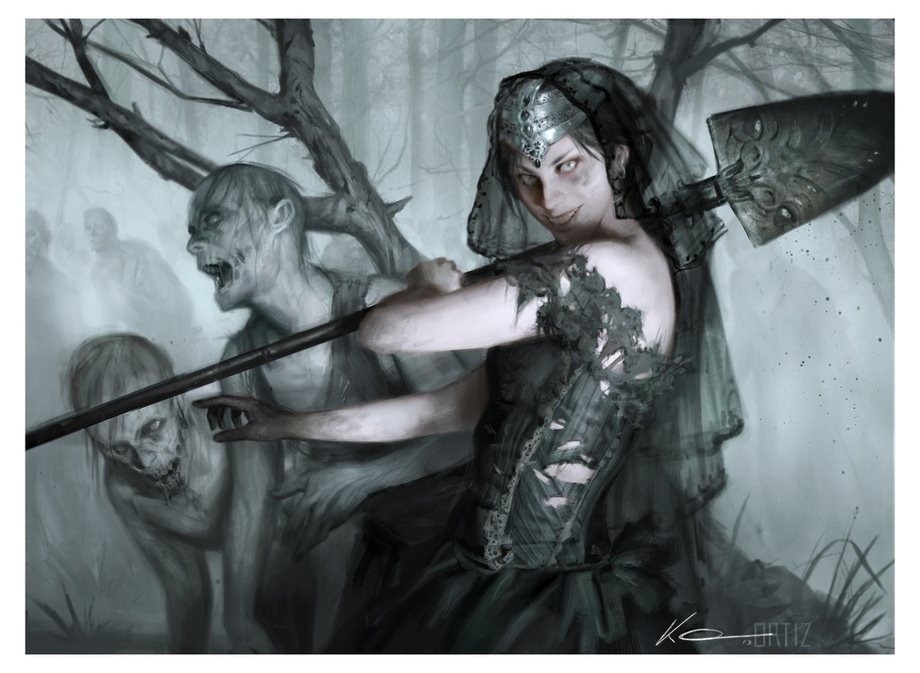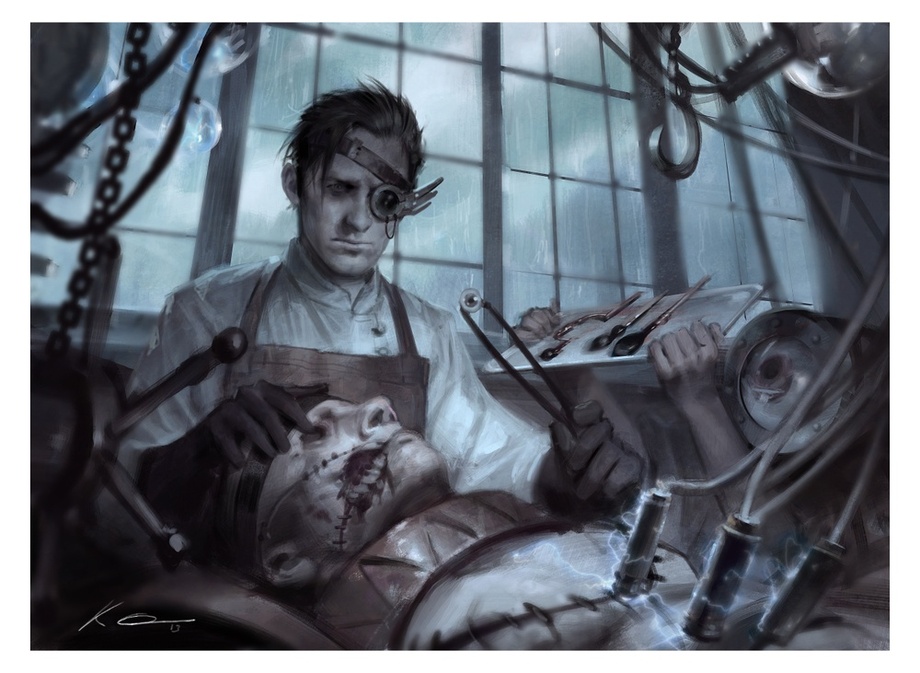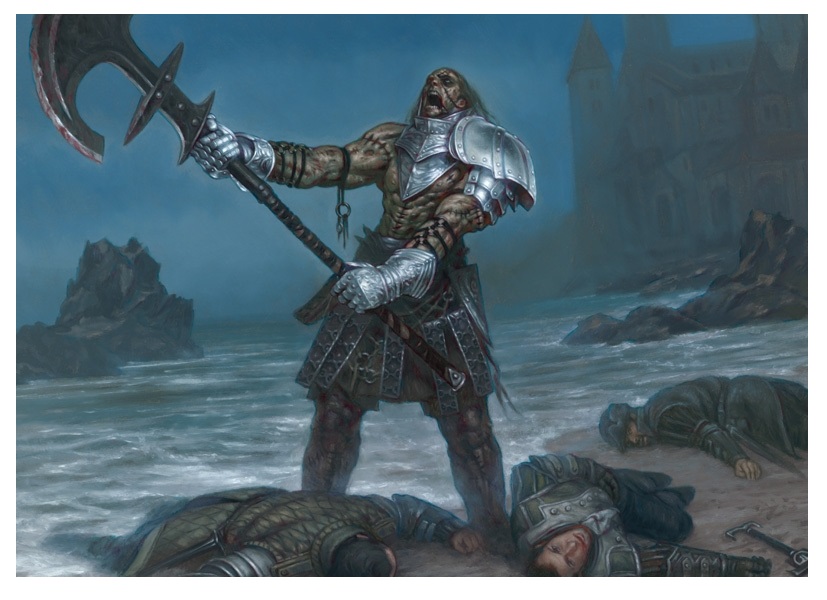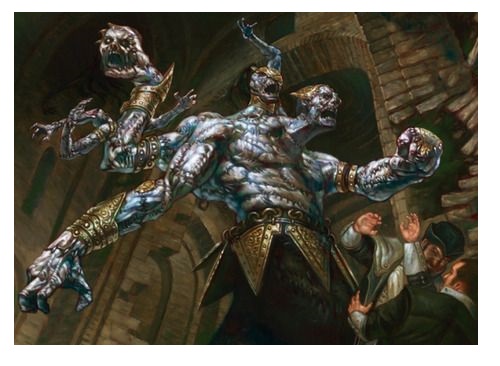Gisa and Geralf Cecani
The Cecani famaily was regarded in high esteem. But after a scandal, the family moved from the human city of Thraben to the Moorland. When the two were children, they both practiced necromancy, but the methods they used were different. Gisa practiced ghoulcalling, an art of summoning zombies through singing and whistling. Geralf practiced stitching, the art of taking parts from dead beings or machines and combine them to create new monsters called skaabs. Due to their differences, the two grew to despise each other and often got into fights. They were responsible for burning their home to the ground on accident. After this, the two went their separate ways with Geralf conquering Trostad and Gisa moving to Nephalia. As they grew up, their motivations for their actions changed. Geralf wished to conquer as much land as he could, while Gisa just wanted to mess with her brother. Due to their disagreements, the two went to war. Geralf made rules to their battle which are called The Five Laws of NecroWarfare

Gisa the Mad
“Geralf, must you always whine? I agreed to nothing. I’ll raise ghouls anytime I wish.” - Gisa to her brother, Geralf.
The Ghoulcaller of the Moorlands, Gisa Cecani is known throughout the civilized places of Innistrad as one of the most talented and dangerous necromances the world has ever seen. Defying her brother's imposed 'rules' of NecroWarfare at every turn, the armies of undead she called from the earth ravage the costal regions of Nephalia nearly every fortnight.
Gisa resides at the Cecani family estate, though the building could more accurately be described as a ruin, staffed by ghouls and the corpses of her former family and their attendants. Gisa cares for nobody but herself and has seemingly no greater ambition than the death and humiliation of her brother. However, the people of Nephalia and the wider regions of Innistrad live in fear of the day that Gisa's ambitions grow, and she turns her talents towards conquest...or worse.
Gisa Cecani
Medium humanoid (human), chaotic evil
- Armor Class 12 (15 with mage armor)
- Hit Points 90 (12d8 + 36)
- Speed 30 ft.
STR DEX CON INT WIS CHA 15 (+2) 14 (+2) 16 (+3) 18 (+4) 12 (+1) 11 (+0)
- Saving Throws Int +9, Wis +6
- Skills Arcana +9, History +9
- Damage Resistances necrotic
- Senses passive Perception 11
- Languages Abyssa, Celestial, Common
- Challenge 10 (5,900 XP)
Spellcasting. Gisa is a 16th-level spellcaster. Her spellcasting ability is Intelligence (spell save DC 17, +9 to hit with spell attacks). Gisa has the following wizard spells prepared:
Canptrips (at will); chill touch, dancing lights, mage hand, ray of frost
1st level (4 slots): false life, hideous laughter, mage armor, ray of sickness
2nd level (3 slots): bindness/deafness, darkness ray of enfeeblement, web
3rd level (3 slots): animate dead, bestow curse, fear, vampiric touch
4th level (2 slots): blight, dimension door, stoneskin
5th level (2 slots): arcane hand, cloudkill
6th level (1 slot): circle of death
7th level (1 slot): finger of death
8th level (1 slot): antipathy/sympathy
Grim Harvest (1/Turn). When Gisa kills a creature that is neither a construct nor undead with a spell of 1st level or higher, she regains hit points equal to twice the spell's level, or three times if it is a necromancy spell.
Actions
Gisa's Spade. Melee Attack: +9 to hit, reach 5 ft., one creature. Hit: 9 (1d8 + 4) bludgeoning damage plus 10 (2d8) necrotic damage.
Ghoulcaller's Chant (Recharges after 7 Long Rests). Gisa summons up to 20 ghouls under the command of 5 ghasts. The creatures are loyal to her and follow her commands to the best of their ability. Gisa can command them telepathically as long as she is within 1 mile of the creatures.
Geralf Cecani
Medium humanoid (human), lawful evil
- Armor Class 16 (breastplate)
- Hit Points 90 (12d8+36)
- Speed 30 ft.
STR DEX CON INT WIS CHA 9 (-1) 18 (+4) 16 (+3) 19 (+4) 14 (+2) 10 (+0)
- Saving Throws Con +8, Int +9
- Skills Arcana +9, Medicine +7
- Damage Resistances necrotic
- Damage Immunities poison
- Condition Immunities poison
- Senses passive Perception 10
- Languages Abyssal, Celestial, Common
- Challenge 10 (5,600 XP)
Spellcasting. Geralf is a 17th-level spellcaster. His spellcasting ability is Intelligence (spell save DC 17, +9 to hit with spell attacks). Geralf has the following artificer spells prepared:
Canptrips (at will); acid splash, mending, poison spray, shocking grasp
1st level (4 slots): absorb elements, catapult
2nd level (3 slots): blur, enlarge/reduce
3rd level (3 slots): dispel magic, fly
4th level (3 slots): blight
5th level (1 slots): cloudkill
Necro-Alchemy. If Geralf casts a spell that requires concentration, he may choose an undead construct within 30 feet of him. That creature gains a bonus to attack and damage rolls equal to the level of the spell (maximum of +3) until he loses concentration.
Actions
Acid Splash Range Spell Attack: DC 17 Dexterity saving throw, range 60 ft., one creature or two within 5 feet of each other. Hit 20 (4d6 + 4) acid damage
Poison Spray Range Spell Attack: DC 17 Constitution saving throw, range 10 ft., one creature. Hit 32 (4d12 + 4) poison damage
Shocking Grasp Melee Spell Attack: +9 to hit, range 5 ft., one creature. Hit 20 (4d8) lightning damage. The target can't take reactions until the start of its next turn. This attack has advantage if the target is wearing armor made of metal.
Reactions
Protect the Master. If Geralf would be hit by an attack, he can command an undead construct under his control within 10 feet of him to intercept the attack instead. When he does, the skaab moves to within 5 feet of him and is treated as the target of the attack.
Stitcher Geralf
“Amazing, isn’t it, how scraps can come together to create such a wonder?” - Geralf Cecani
Unlike his sister, Gisa, Geralf has never lacked for ambition or the drive to pursue his goals. Geralf is a skaberen - an individual that melds the practicies of necromancy and alchemy, as well as scientific practice, to stitch together creatures known as skaabs and animating them to serve their goals. Unlike ghouls and other undead, skaabs are often stronger than any individual corpse, being made of several bodies and often borrowing the most promising or well-developed traits of each. However, this higher quality of servant means that skaabs often take longer to stitch together, and are less readily available as footsoldiers than the common ghoul or zombie.
If not for his sister's constant assaults on his laboratory in Trostad, Geralf's ambitions might be the greatest threat to all of Innistrad. However, Gisa's constant interruptions and attacks keep the skaberen's attention focused on things aside from domination and submission of the masses. His proposal of the laws of NecroWarfare was an attempt to circumvent her single-minded feuding, however, the results have so far been less than ideal.

Skaabs
Those who study it are quick to tell you that necro-alchemy is much more of an art than ghoulcalling. One who practices the art of creating skaabs is called a skaberen. The true goal of the skaberen is to create life, an undertaking which usually produces malformed "offspring" rather than true life.
There are four steps to producing a skaab:
- Corpus Creare, also known as "corpse cobbling," is the collecting of various anatomical parts from corpses from which the skaab will be constructed. This is usually performed by paid grave robbers or homunculi under the skaberen's charge. In some cases, even the limbs of beasts are used for the construct; if a human arm is not available, a horse's leg can suffice.
- Patin Ligitus, or rune-bonds, are the "binding plates" used to join various anatomical features together. These are plates of copper and/or brass, with silver-inlaid runes scribed on them. They provide an arcane bridge of sorts between disparate parts gathered by corpse-cobbling.
- Viscus Vitae, or vital fluid, is the key to the skaberen's art. Viscus vitae is created by mixing a large quantity of lamp oil with the slightest pinch of the dried blood of an angel. Once a perfect mixture of viscus vitae is created, any blood remaining in the corpse is replaced with vital oil, via transfusion. As a result, skaab are often highly flammable.
- Vox Quietus, translated as "the silent word," is the final step in creating a skaab. The skaberen whispers a fairly lengthy incantation over the corpse which awakens the creature, but in a much calmer manner that that which is used by ghoulcallers. Once awakened, the skaab is in a calm, "tabula rasa" state, which allows the alchemist to begin the long task of re-educating the creature. In the eyes of a skaberen, the technique used by ghoulcallers is crude, heretical, and provides unacceptable results.
Skaberen usually ply their trade in remote and inhospitable places, since they are viewed as blasphemers by commoners and clergy. Skaberen often become obsessed hermits who surround themselves with ancient scrolls and books, phials of rare noxious liquids, glass jars full of pickled organs, anatomical charts for both human and beast, rune-engraved skeletal remains, and small anvils and hammers for inscribing runes on brass and copper plates.

Armored Skaab
Armored skaabs serve as general infantry to any practiced skaberen. Generally considered to be entry-level constructs and examples of the art, these creatures often feature salvaged armor grafted to their flesh to increase their durability. Unlike others of their kind, these creatures are literally made for battle.
Armored Skaab
Medium undead construct, neutral
- Armor Class 17 (grafted armor)
- Hit Points 93 (11d8 + 44)
- Speed 30 ft.
STR DEX CON INT WIS CHA 19 (+4) 8 (-1) 18 (+4) 6 (-2) 10 (+0) 5 (-3)
- Damage Immunities lightning, poison; bludgeoning, piercing, and slashing from nonmagical attacks not made with adamantine weapons
- Condition Immunities charmed, exhaustion, frightened, paralyzed, petrified, poisoned
- Senses darkvision 60 ft., passive Perception 10
- Languages understands the languages of its creator but can’t speak
- Challenge 6 (2,300 XP)
Viscus Vitae. If the skaab takes fire damage, it has disadvantage on attack rolls and ability checks until the end of its next turn. If it is below half health, it bursts into flame and takes an additional 1d6 fire damage at the beginning of its turn until an action is used to extinguish it. If fire damage reduces the skaab to 0 hit points, it detonates, dealing 8d6 fire damage to each creature within 20 feet, or half as much on a DC 15 Dexterity saving throw.
Immutable Form. The skaab is immune to any spell or effect that would alter its form.
Lightning Absorption. Whenever the skaab is subjected to lightning damage, it takes no damage and instead regains a number of hit points equal to the lightning damage dealt.
Magic Resistance. The skaab has advantage on saving throws against spells and other magical effects.
Magic Weapons. The skaab's weapon attacks are magical.
Actions
Multiattack. The skaab makes two greataxe attacks
Greataxe. Melee Weapon Attack: +7 to hit, reach 5 ft., one target. Hit: 18 (2d12 + 4) slashing damage
Variant: Stitchwing Skaab
Some ambitious skaberen try to push their basic creations even further into the realm of the unnatural, grafting wings to humanoid forms. Such skaabs must be unarmored, and have an AC of 9. They also attack with slam attacks which deal 14 (2d8 + 4) bludgeoning damage. However, their grafted wings grant them a fly speed of 40 ft.
Stitched Drake
Large undead construct, neutral
- Armor Class 12 (natural armor)
- Hit Points 123 (13d10 + 52)
- Speed 20 ft., fly 80 ft.
STR DEX CON INT WIS CHA 20 (+5) 7 (-2) 18 (+4) 5 (-3) 12 (+1) 6 (-2)
- Skills Perception +4
- Damage Immunities lightning, poison; bludgeoning, piercing, and slashing from nonmagical attacks not made with adamantine weapons
- Condition Immunities charmed, exhaustion, frightened, paralyzed, petrified, poisoned
- Senses darkvision 60 ft., passive Perception 14
- Languages understands the languages of its creator but can’t speak
- Challenge 8 (3,900 XP)
Viscus Vitae. If the drake takes fire damage, it has disadvantage on attack rolls and ability checks until the end of its next turn. If it is below half health, it bursts into flame and takes an additional 1d6 fire damage at the beginning of its turn until an action is used to extinguish it. If fire damage reduces the drake to 0 hit points, it detonates, dealing 8d6 fire damage to each creature within 20 feet, or half as much on a DC 15 Dexterity saving throw.
Immutable Form. The drake is immune to any spell or effect that would alter its form.
Lightning Absorption. Whenever the drake is subjected to lightning damage, it takes no damage and instead regains a number of hit points equal to the lightning damage dealt.
Magic Resistance. The drake has advantage on saving throws against spells and other magical effects.
Magic Weapons. The drake's weapon attacks are magical.
Actions
Multiattack. The drake makes two attacks: one with its bite and one with its stinger. While flying, it can use its claws in place of one other attack.
Bite. Melee Weapon Attack: +8 to hit, reach 10 ft., one creature. Hit: 13 (2d6 + 5) piercing damage.
Claws. Melee Weapon Attack: +8 to hit, reach 5 ft., one target. Hit: 15 (2d8 + 5) slashing damage.
Stinger. Melee Weapon Attack: +8 to hit, reach 10 ft., one creature. Hit: 13 (2d6 + 5) piercing damage plus 28 (7d6)poison damage. The target must make a DC 15 Constitution saving throw, taking the poison damage on a failed save, or half as much damage on a successful one.
Stitched Drake
Drakes are hardly an uncommon sight on Innistrad, especially in coastal areas like Nephalia. These distant cousins of dragons are solitary predators and often called the wolves of the skies. Their majesty in the air has inspired many throughout history, including ambitious and creative skaaberen.
Unlike their living counterparts, stitched drakes tend to be somewhat less dexterous and graceful in flight. However, what they lack in dexterity, they more than make up for in strength, fortitude and - of utmost importance to their skaberen creator - loyalty.
Skaab Goliath
If skaberen consider the human form to be a template for their bizarre and unnatural creations, then the skaab goliath can be considered the apex of what this form can achieve. The body of these creatures are often stitched together from a minimum of a dozen humanoid corpses, often enhanced with limbs and musculature of large beasts of burden.
The oversized limbs and hulking forms are difficult to control, and thus the creatures are almost always grafted with three heads to house additional brains. This has its own set of advantages, making the creature more difficult to blind or otherwise incapacitate.
Skaberen who seek to create such abominations rarely keep more than one under their control at a time, as even with the control they exercise over such creatures, goliaths are disruptive to everyday life, and are difficult to conceal from one's neighbors.

Skaab Goliath
Huge undead construct, neutral
- Armor Class 15 (natural armor)
- Hit Points 148 (11d12 + 77)
- Speed 40 ft.
STR DEX CON INT WIS CHA 26 (+8) 10 (+0) 24 (+7) 8 (-1) 12 (+1) 9 (-1)
- Saving Throws Dex +3, Con +10, Wis +4
- Skills Athletics +14, Perception +4
- Damage Immunities lightning, poison; bludgeoning, piercing, and slashing from nonmagical attacks not made with adamantine weapons
- Condition Immunities charmed, exhaustion, frightened, paralyzed, petrified, poisoned
- Senses darkvision 60 ft., passive Perception 19
- Languages understands the languages of its creator but can’t speak
- Challenge 12 (8,400 XP)
Viscus Vitae. If the skaab takes fire damage, it has disadvantage on attack rolls and ability checks until the end of its next turn. If it is below half health, it bursts into flame and takes an additional 1d6 fire damage at the beginning of its turn until an action is used to extinguish it. If fire damage reduces the skaab to 0 hit points, it detonates, dealing 8d6 fire damage to each creature within 20 feet, or half as much on a DC 15 Dexterity saving throw.
Immutable Form. The skaab is immune to any spell or effect that would alter its form.
Lightning Absorption. Whenever the skaab is subjected to lightning damage, it takes no damage and instead regains a number of hit points equal to the lightning damage dealt.
Magic Resistance. The skaab has advantage on saving throws against spells and other magical effects.
Magic Weapons. The skaab's weapon attacks are magical.
Three Heads. The skaab has advantage on saving throws against being blinded, deafened, stunned, or knocked unconscious. It also has advantage on Wisdom (Perception) checks.
Actions
Multiattack. The skaab makes two slam attacks.
Slam. Melee Weapon Attack: +11 to hit, reach 15 ft., one target. Hit: 28 (4d8 + 8) bludgeoning damage
Stomp. Melee Weapon Attack: +11 to hit, reach 5 ft., one target. Hit: 34 (4d10 + 8) bludgeoning damage
Trample (Recharge 5-6). The skaab moves up to his speed and can move through the space of any creature smaller than Huge. The first time the skaab enters a creature’s space during this move, the creature must make a DC 19 Dexterity saving throw. If the saving throw succeeds, the creature is pushed 5 feet away from the skaab. If the saving throw fails, that creature is knocked prone, and the skaab can make a stomp attack against it.